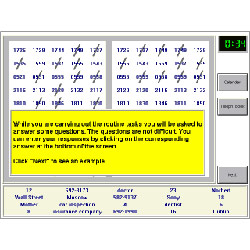
Intended for personnel selection, career counseling, diagnosis and assessment. Additional areas of use are traffic psychology (especially railway and aviation psychology), military psychology as well as within clinical settings.
"Simultaneous Capacity" and "Stress Tolerance" are two of the essential requirements for a multitude of professions. The present test provides a reliable way to measure both constructs.
Operationally SIMKAP is based on the definition of Simultaneous Capacity and Stress Tolerance. Simultaneous Capacity is defined as the performance achieved when simultaneously dealing with routine tasks and tasks demanding cognitive performances (problem solving). More recently the term multi-tasking has been used to denote this talent. Stress Tolerance is defined as the extent to which performance differs when dealing with corresponding routine tasks under normal (baseline) and stress conditions
SIMKAP consists of five subtests. The first three represent the routine tasks and aim at measuring the baseline of Perceptual Speed and Accuracy. They differ in content (Numbers, Letters, Figures). The task is to identify and mark critical items as fast and accurately as possible. In the fourth subtest uncomplicated problem solving is required. The fifth subtest combines the previous ones - both routine tasks of Perceptual Speed / Accuracy and tasks involving problem solving have to be dealt with simultaneously.
At present there is one test form.
The main scoring variables are Simultaneous Capacity and Stress Tolerance. Moreover, Perceptual Speed and Accuracy under normal (baseline) and stressful conditions are assessed.
The reliability coefficients regarding the total performance for Simultaneous Capacity and Stress Tolerance vary between 0.94 and 0.97 and between 0.89 and 0.91 respectively. The parallel test reliability coefficients are 0.96 for Perceptual Speed (baseline) and 0.84 for Accuracy (also baseline).
The face validity is evident – the respondents think immediately of real situations where several things have to be handled simultaneously. The logical validity is given by the operational definition of Simultaneous Capacity and Stress Tolerance. Content validity has been proven through factor analysis. Prognostic validity has been demonstrated for occupations demanding, amongst other prerequisites, a high degree of Simultaneous Capacity and Stress Tolerance. Criteria used were "completed occupational education without complications" and "poor performance on the job".
A further study on prognostic validity carried out by the Swedish marine showed that the SIMKAP differentiates perfectly among speed boat commanders.
Norms of a sample of 436 Austrian adults is available. The norms are also broken down by level of education and age.
The required time for instructions, solving the practice items and actual testing time is approximately 40 minutes.
For the administration of Simultaneous Capacity a sound card and speakers or headphones are necessary.
The Schuhfried VTS enables computer-assisted application of a large number of highly diverse psycho-diagnostic tests and measuring procedures. In developing the system much emphasis was placed on transparent structure and largely uniform design. It is therefore simple to operate and easy to understand and does not require any special computer skills.
The VTS basic module is required for administration of any of the available tests.
The Schuhfried VTS supports the administration of both single tests and test batteries. Many of the single tests are available in different test versions. These test versions may differ, for example, in terms of test duration or difficulty or may be parallel forms. They are characterized by different parameters reflecting specific test requirements. They have been designed for administration to a specific population (e.g. psychiatric patients, children, etc.) or for special measuring purposes (e.g. repeated measurements). Test batteries are compiled from the available single tests and test versions.
The Schuhfried VTS enables computer-assisted application of a large number of highly diverse psycho-diagnostic tests and measuring procedures. In developing the system much emphasis was placed on transparent structure and largely uniform design. It is therefore simple to operate and easy to understand and does not require any special computer skills. This VTS basic module is required for administration of any of the available tests.